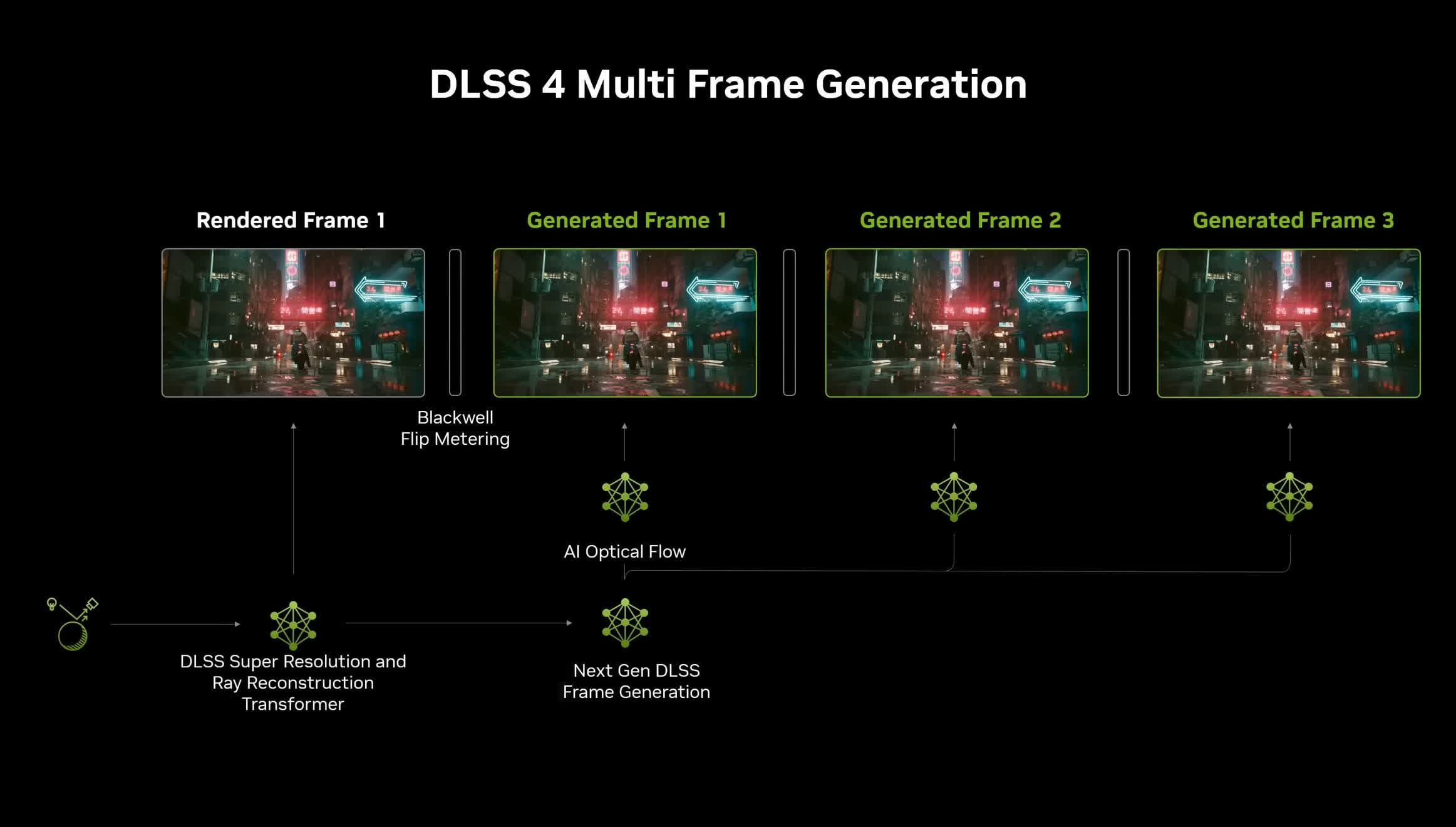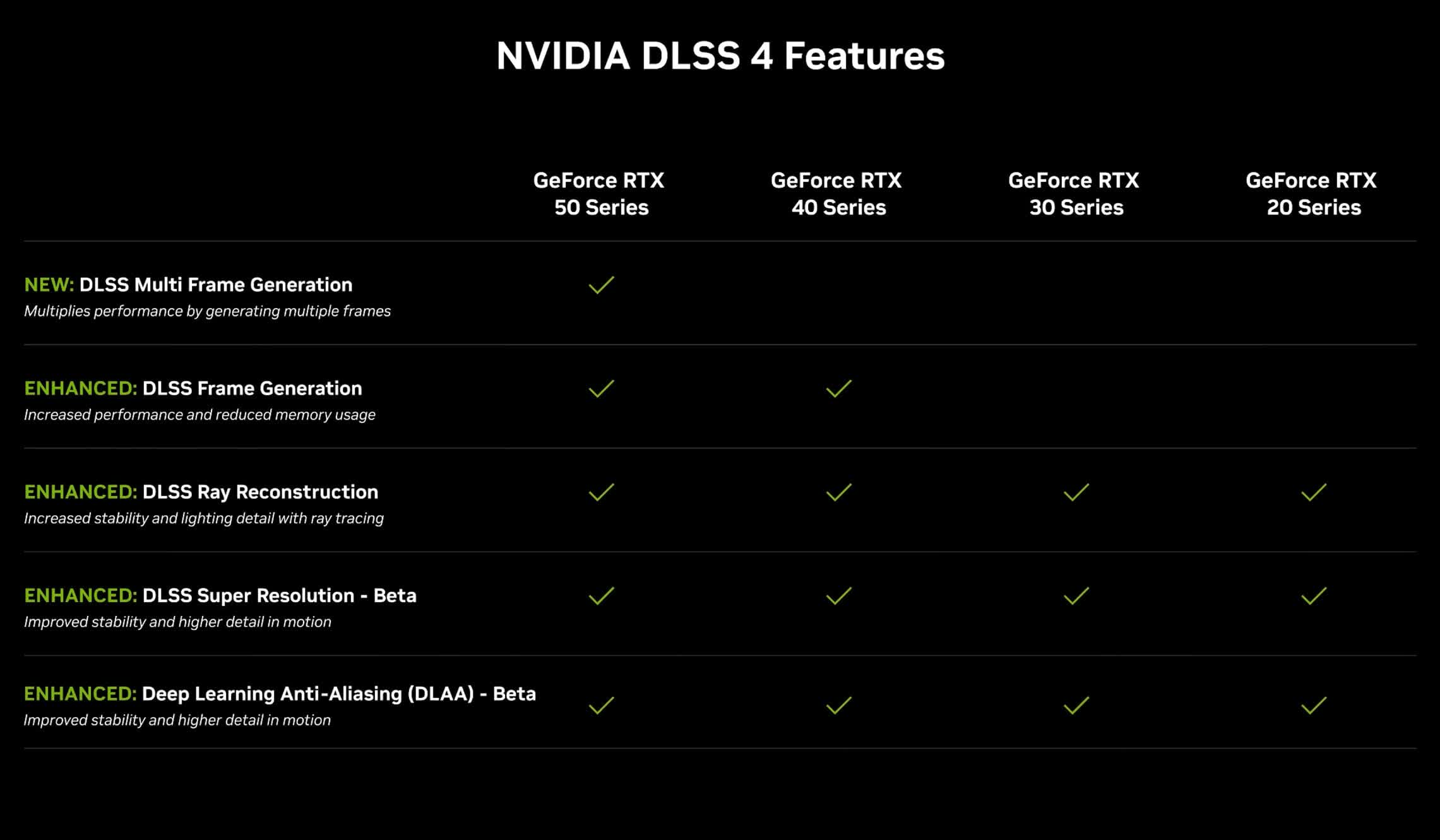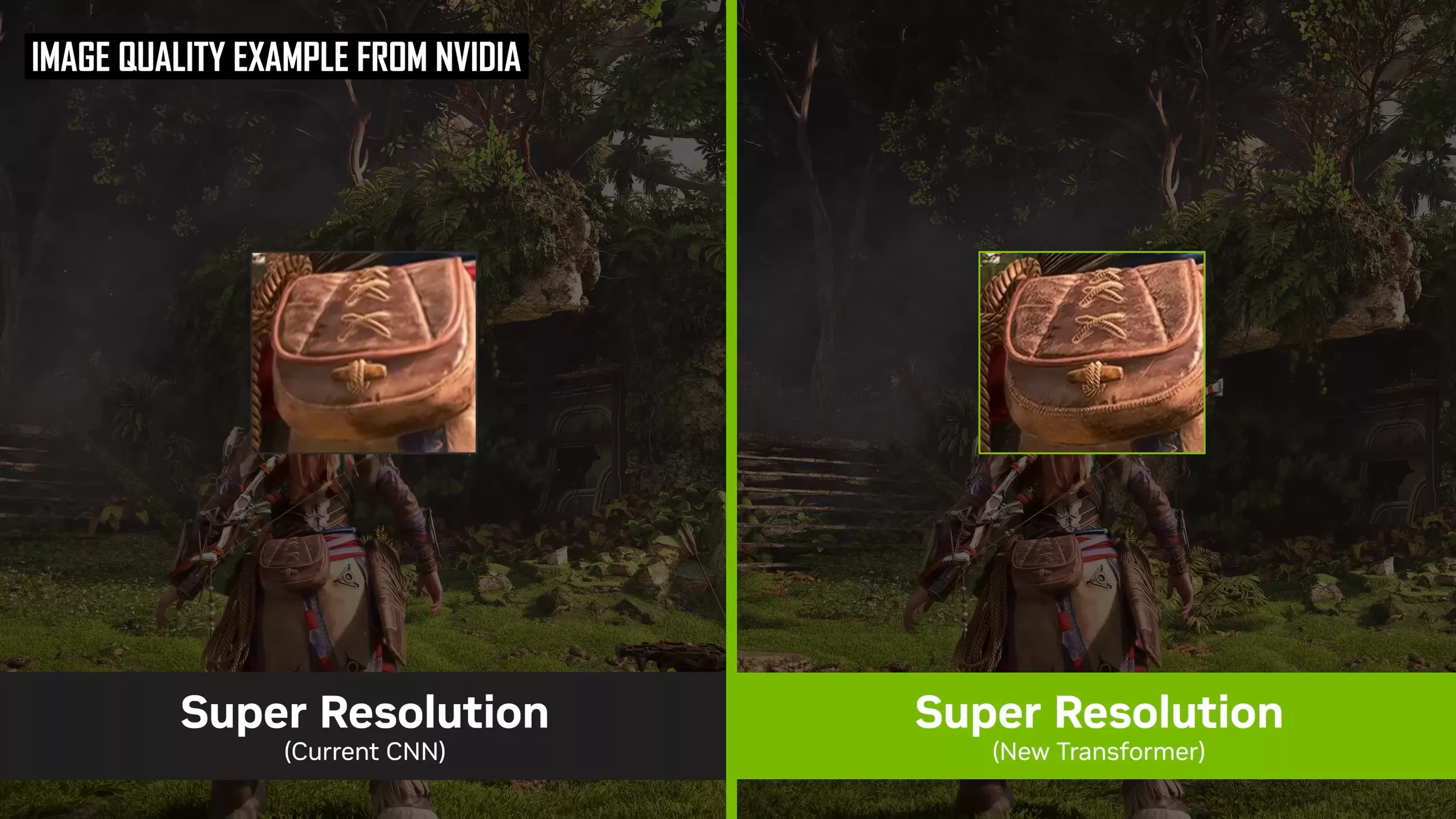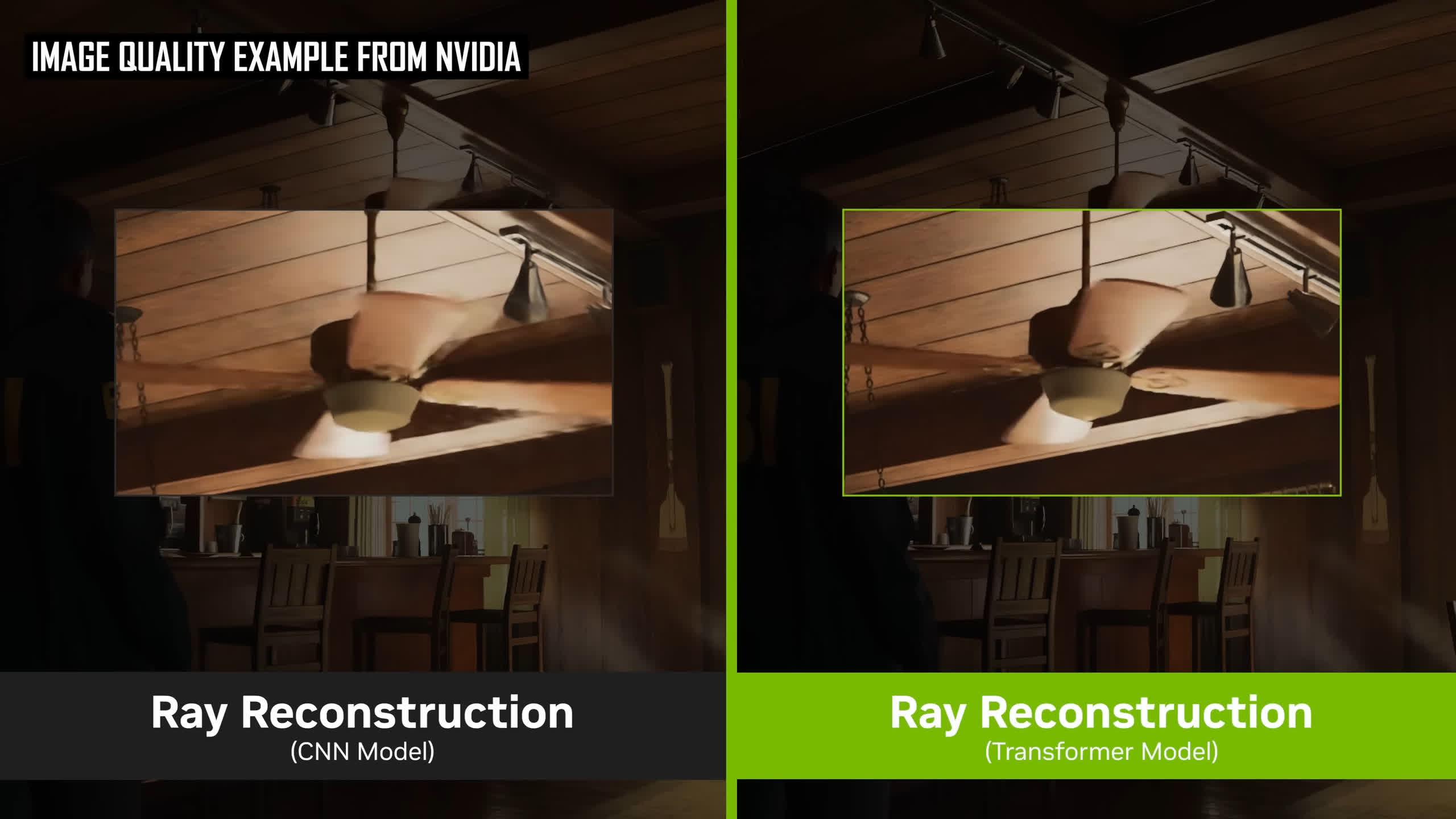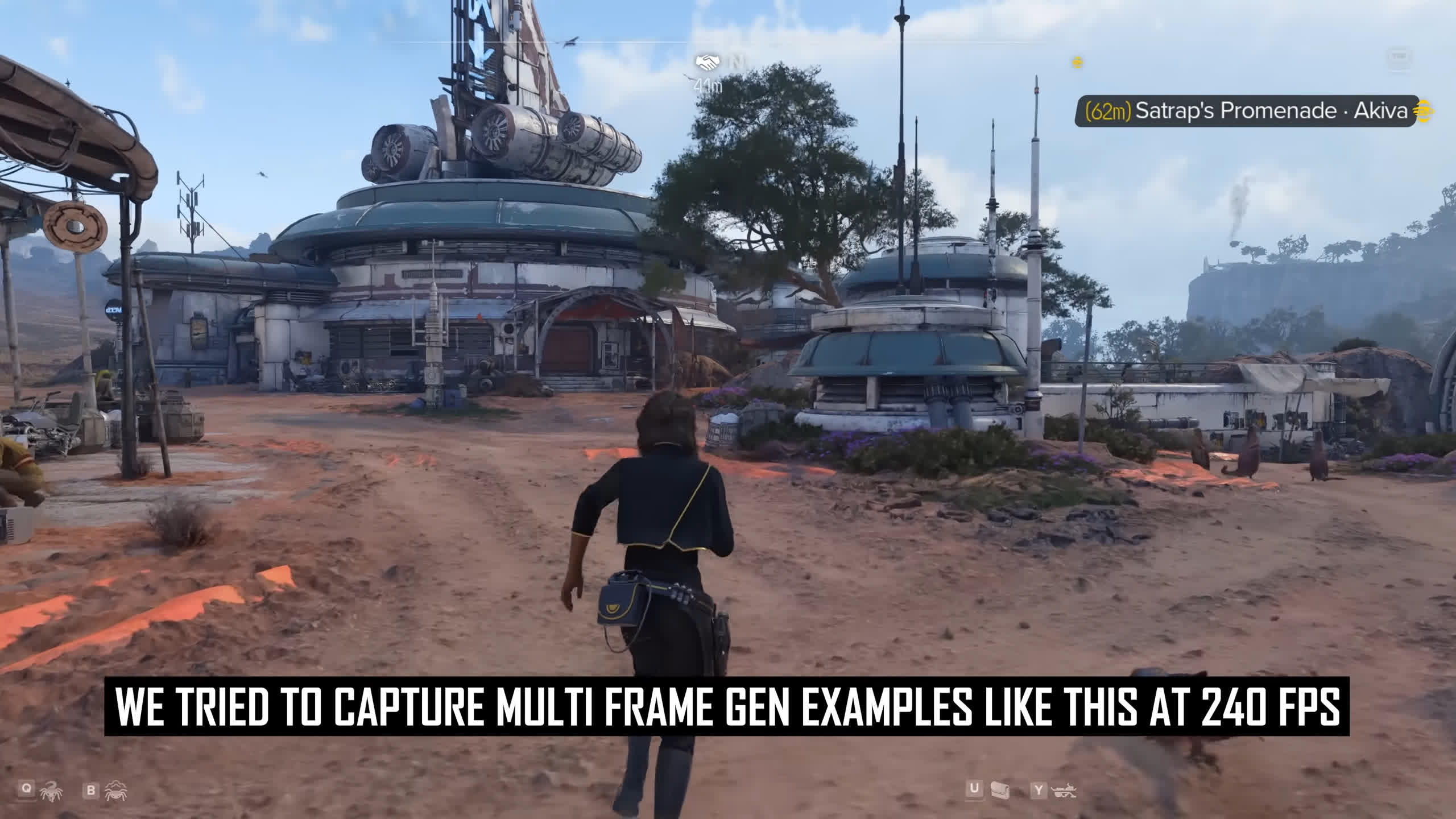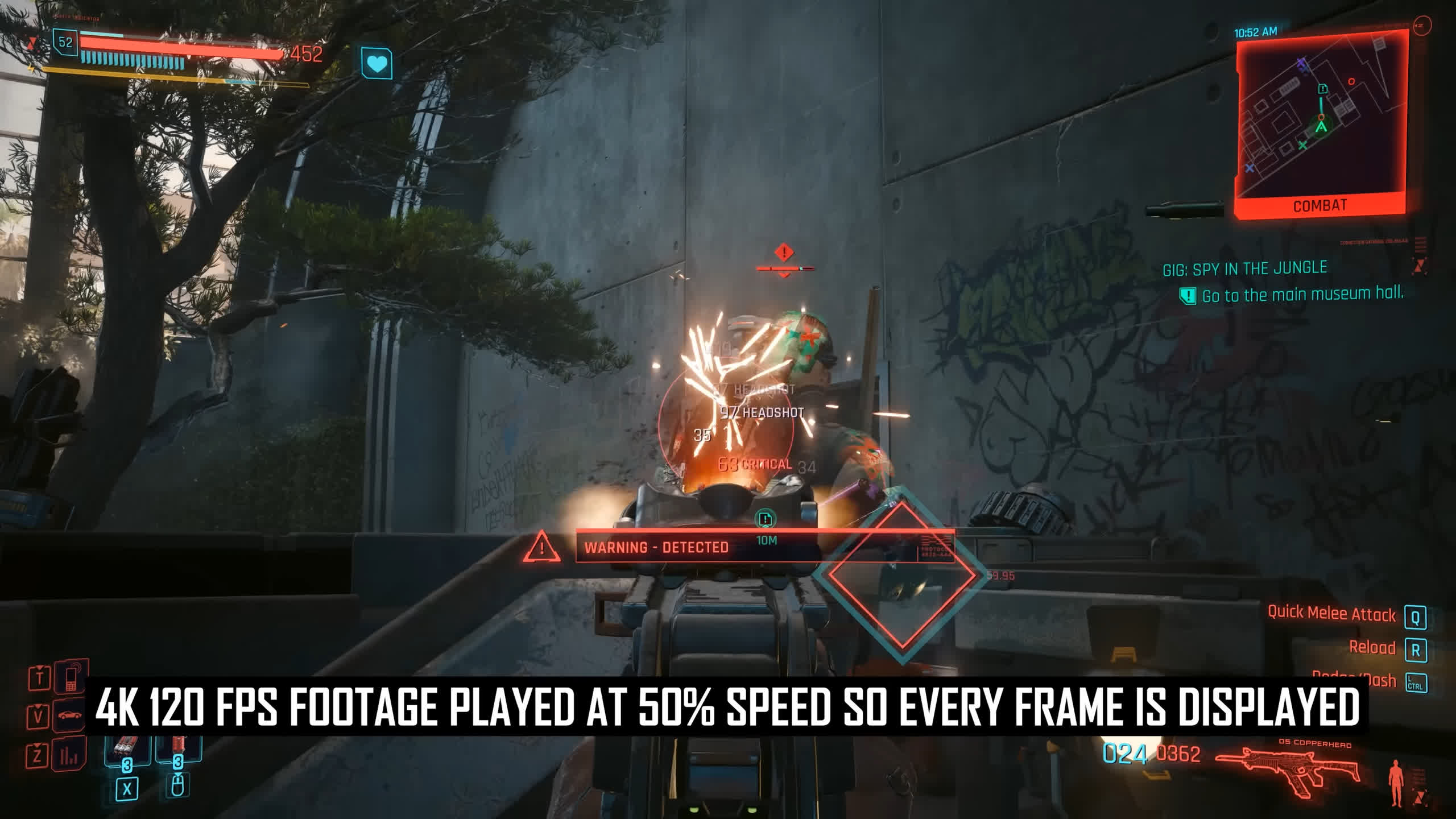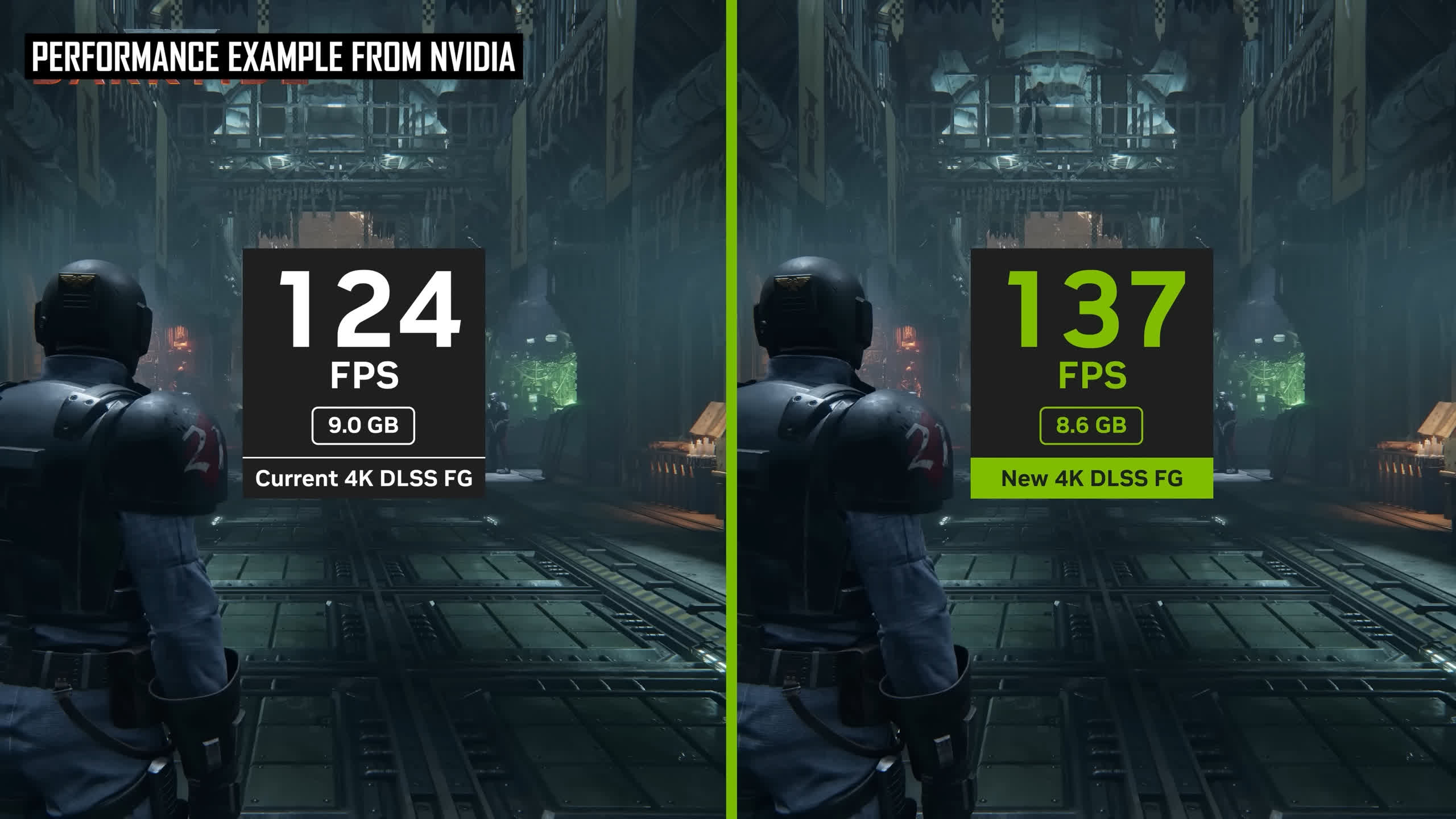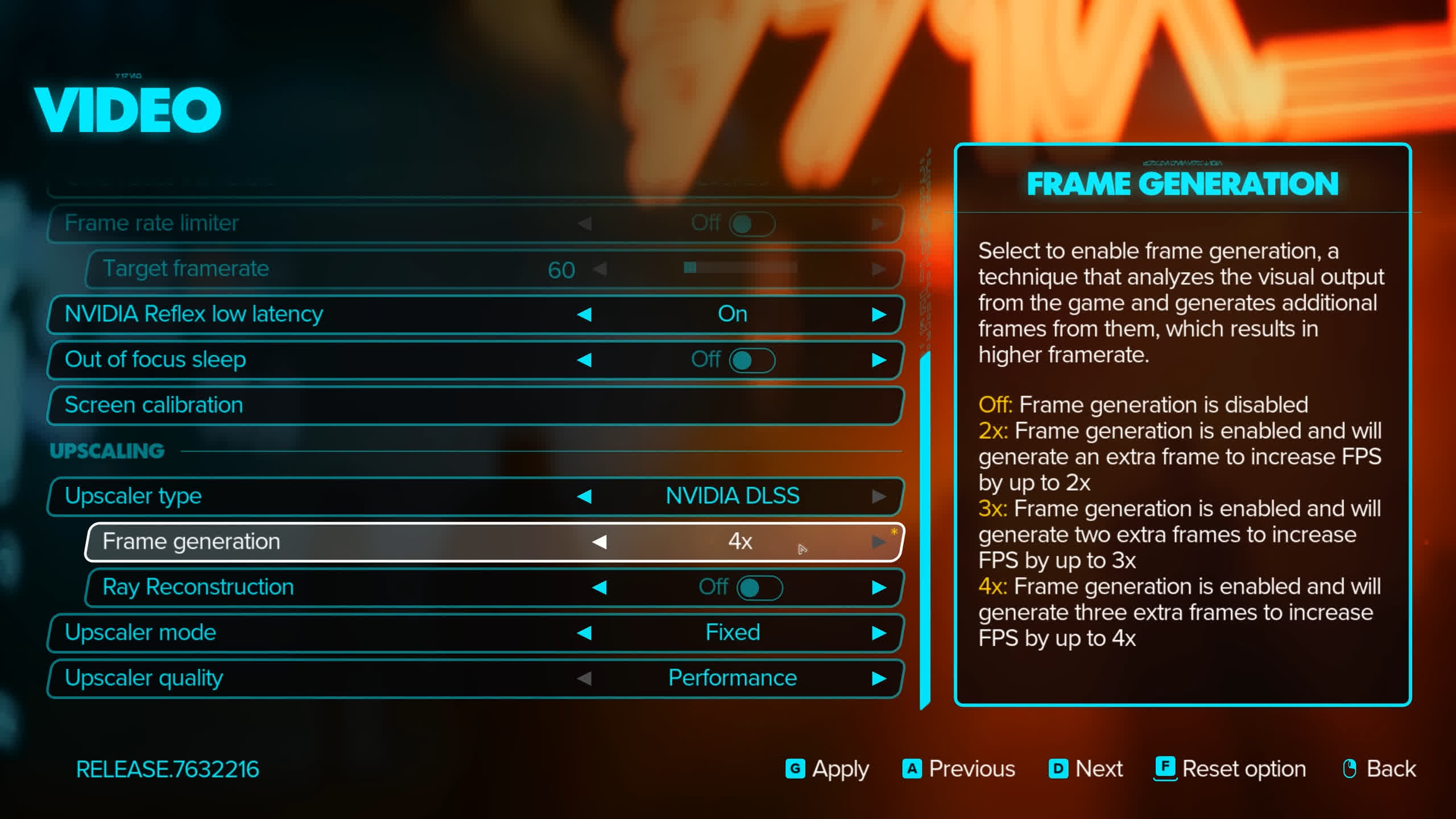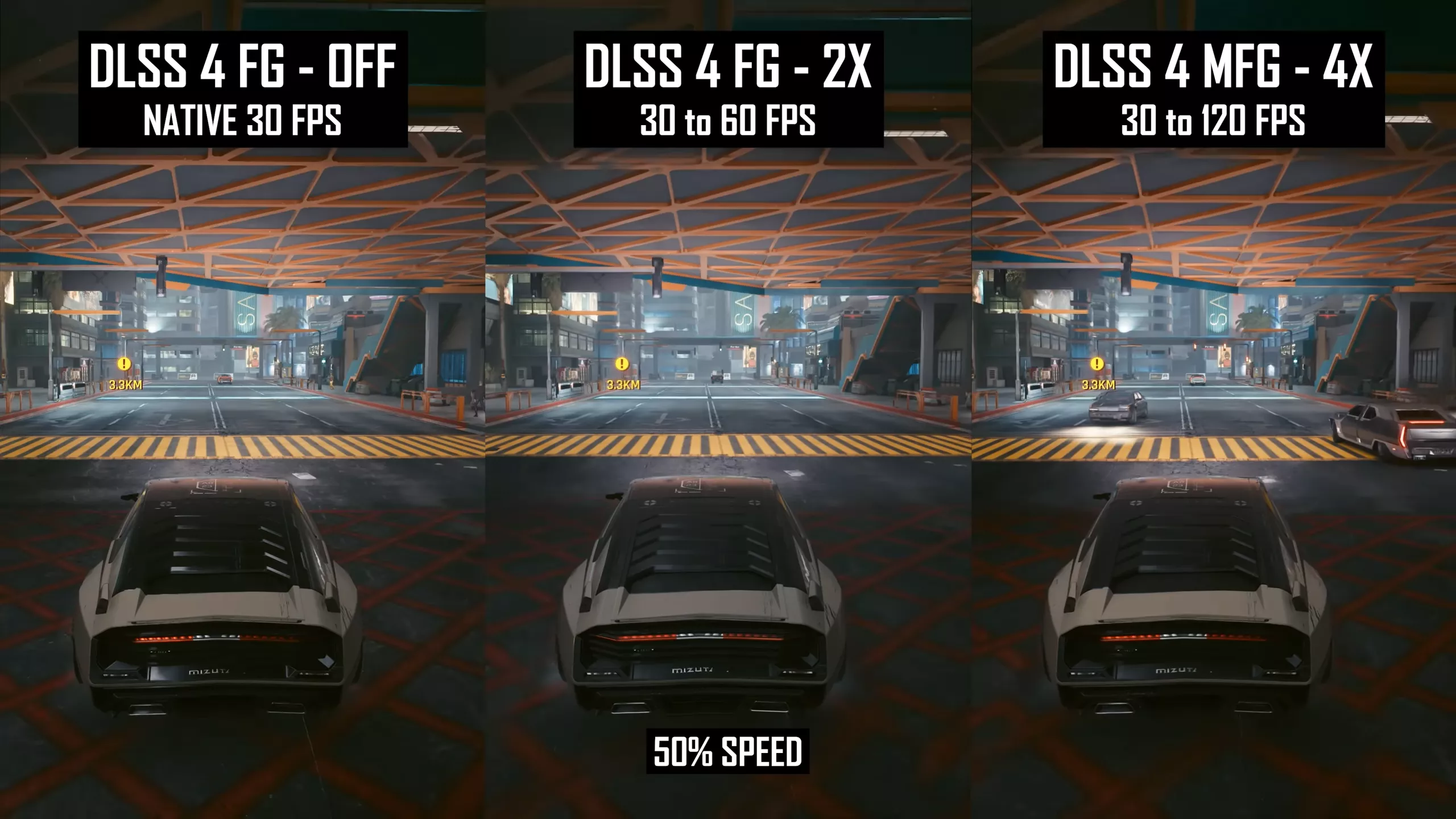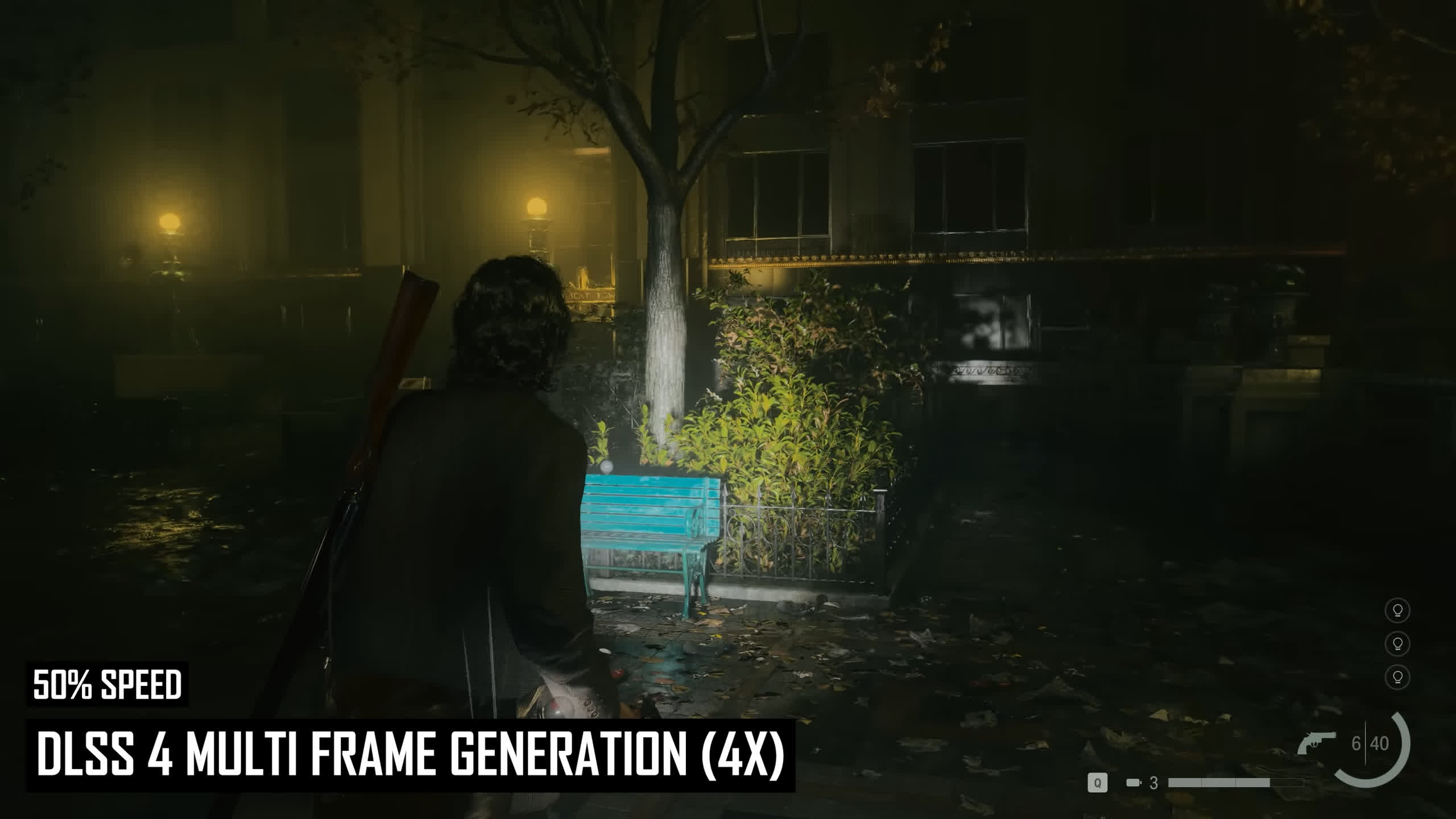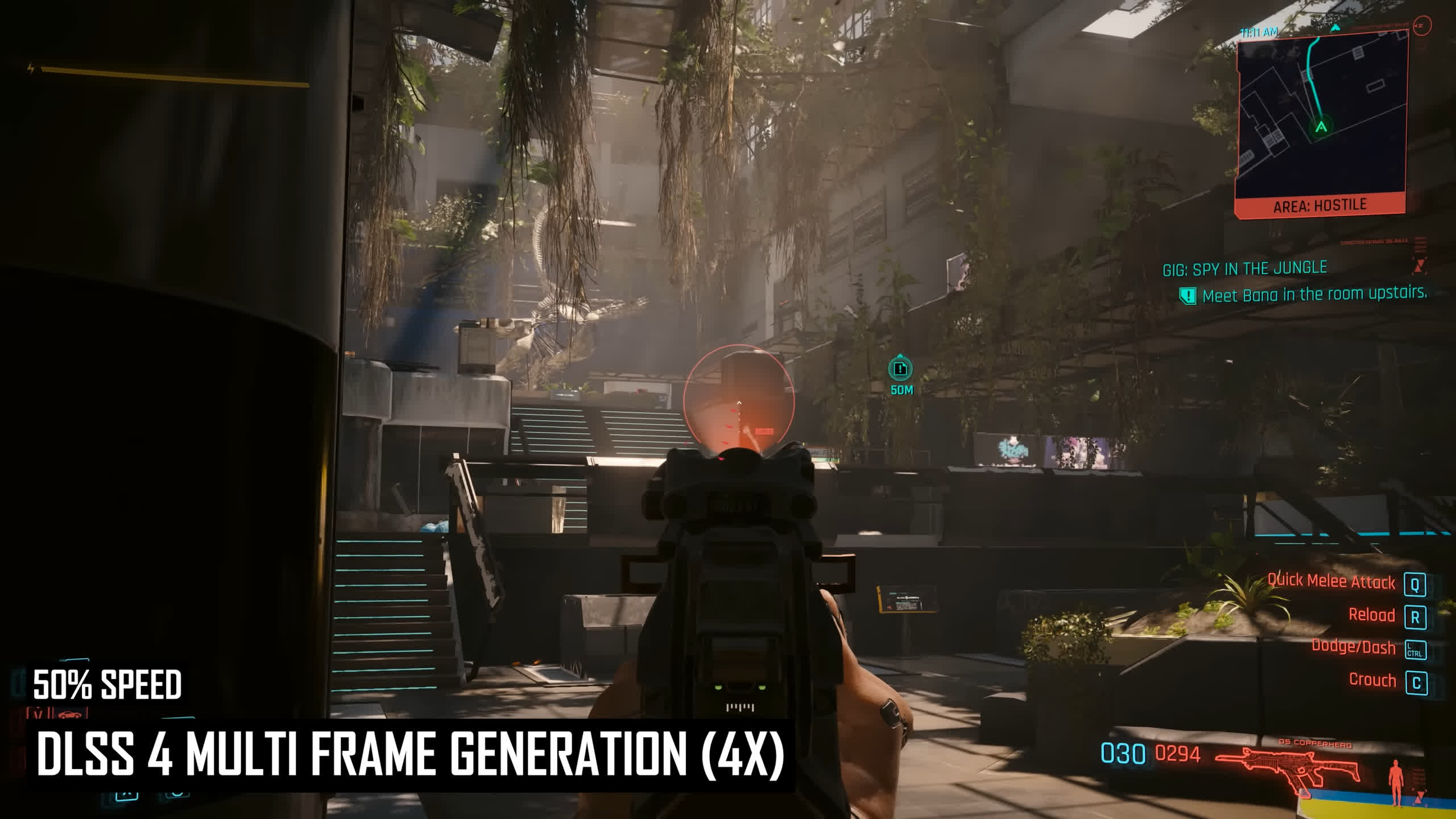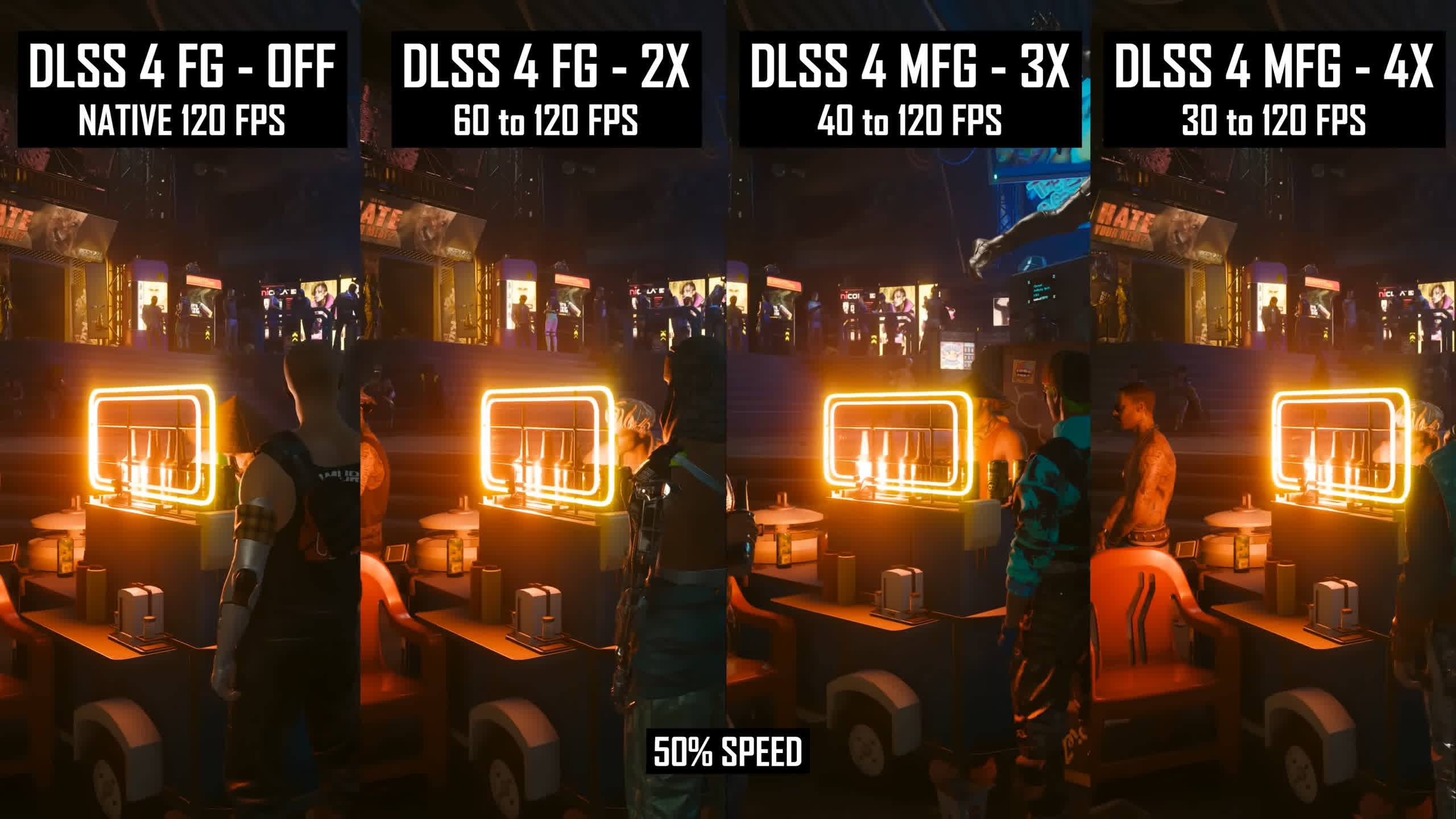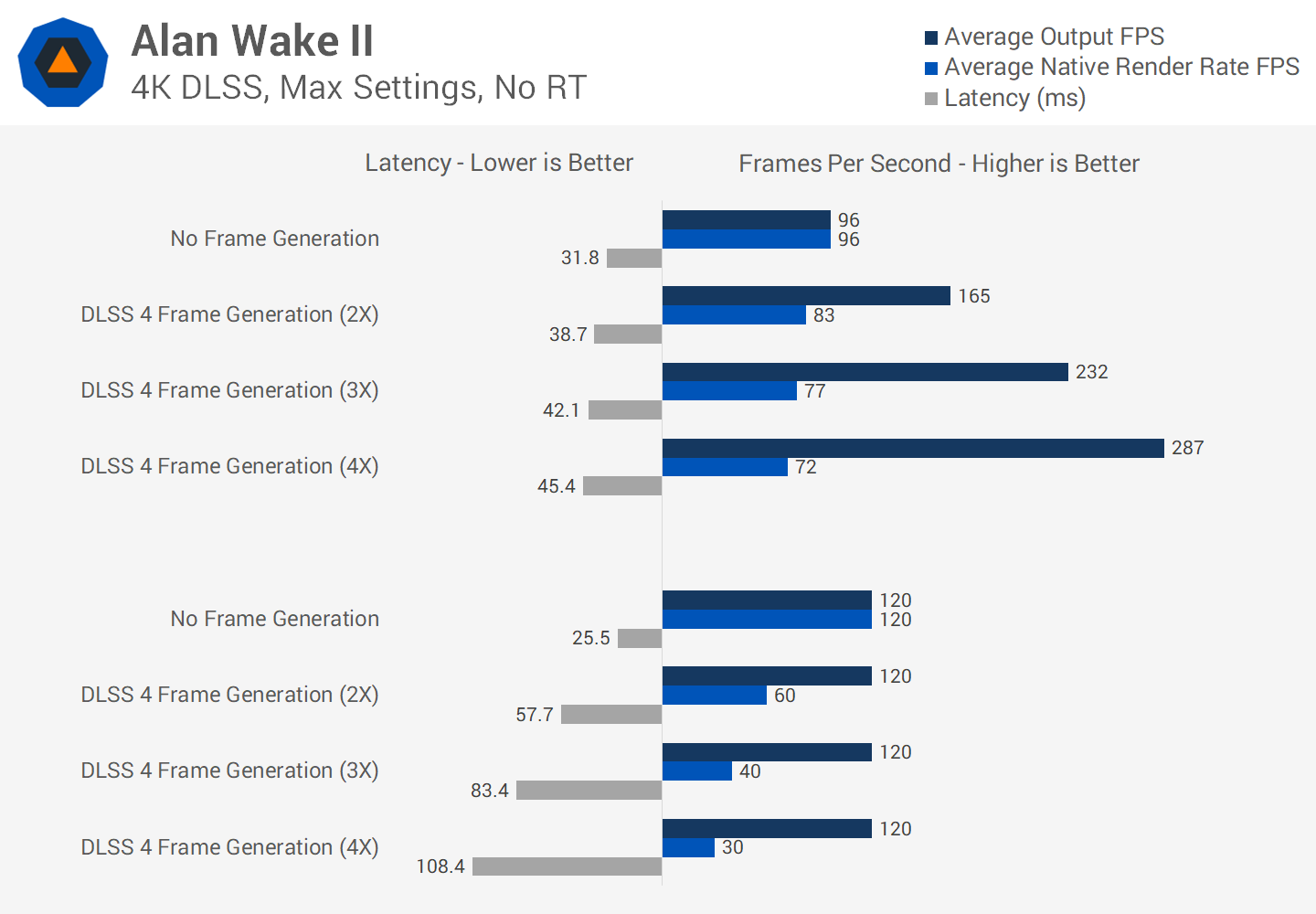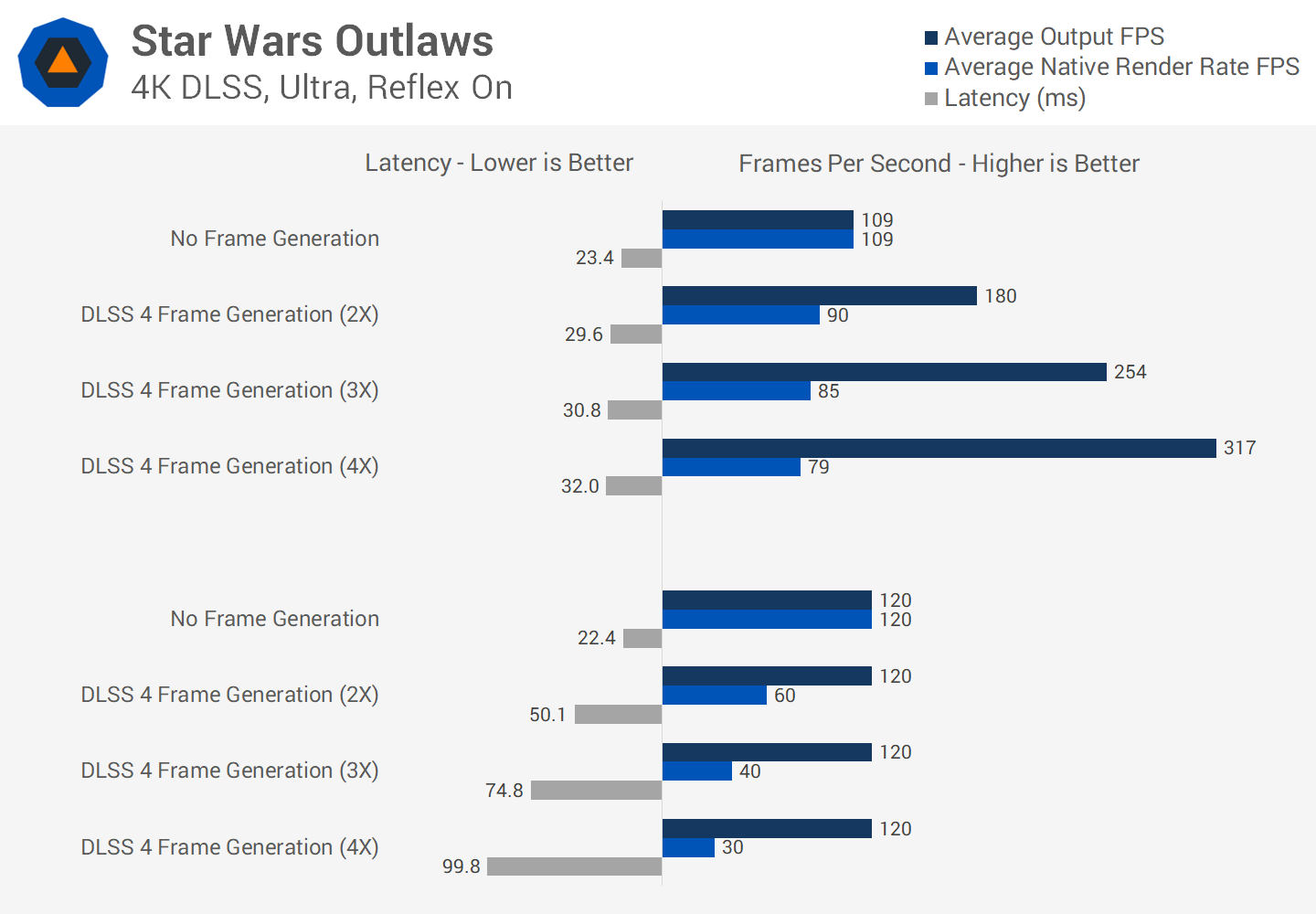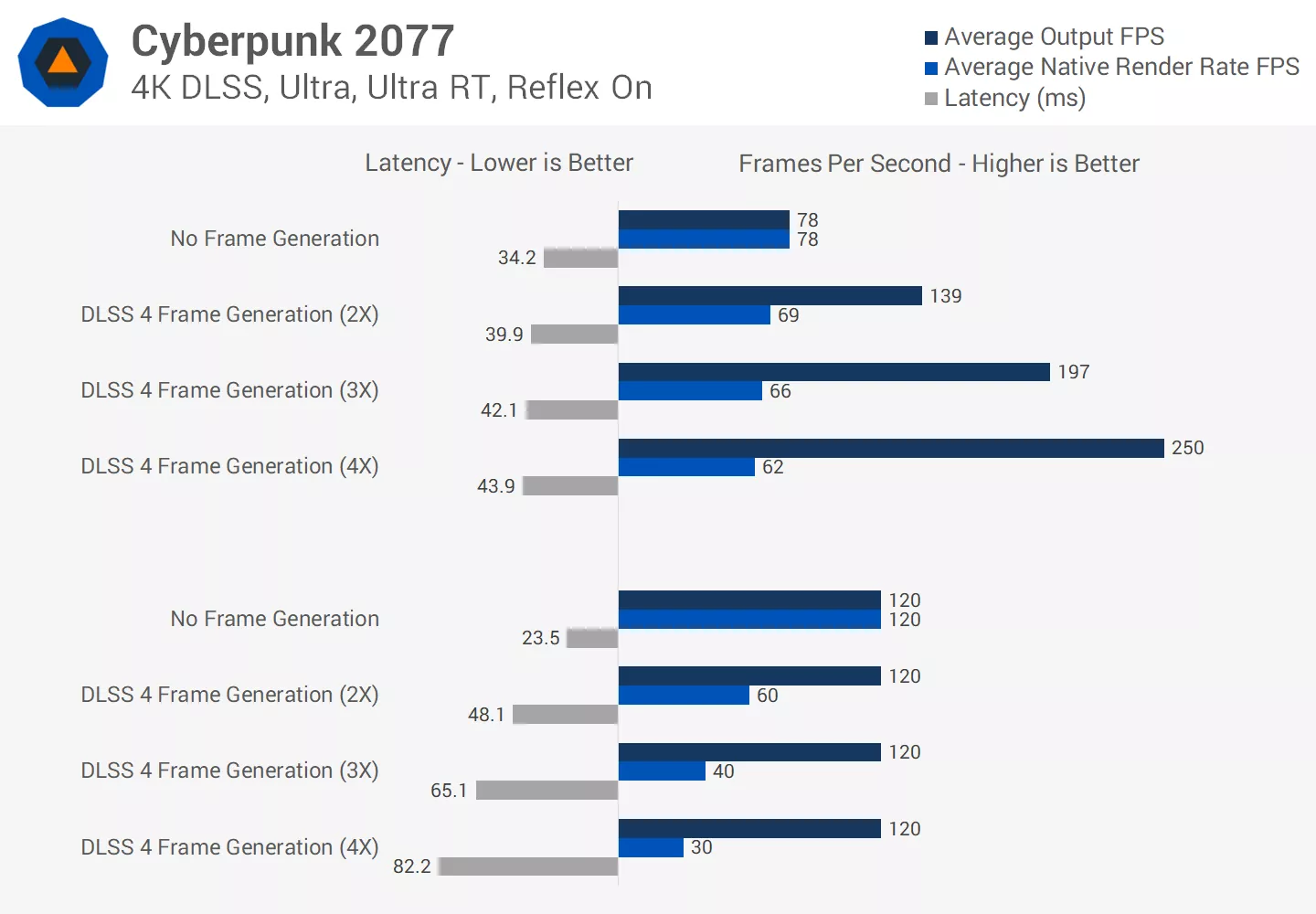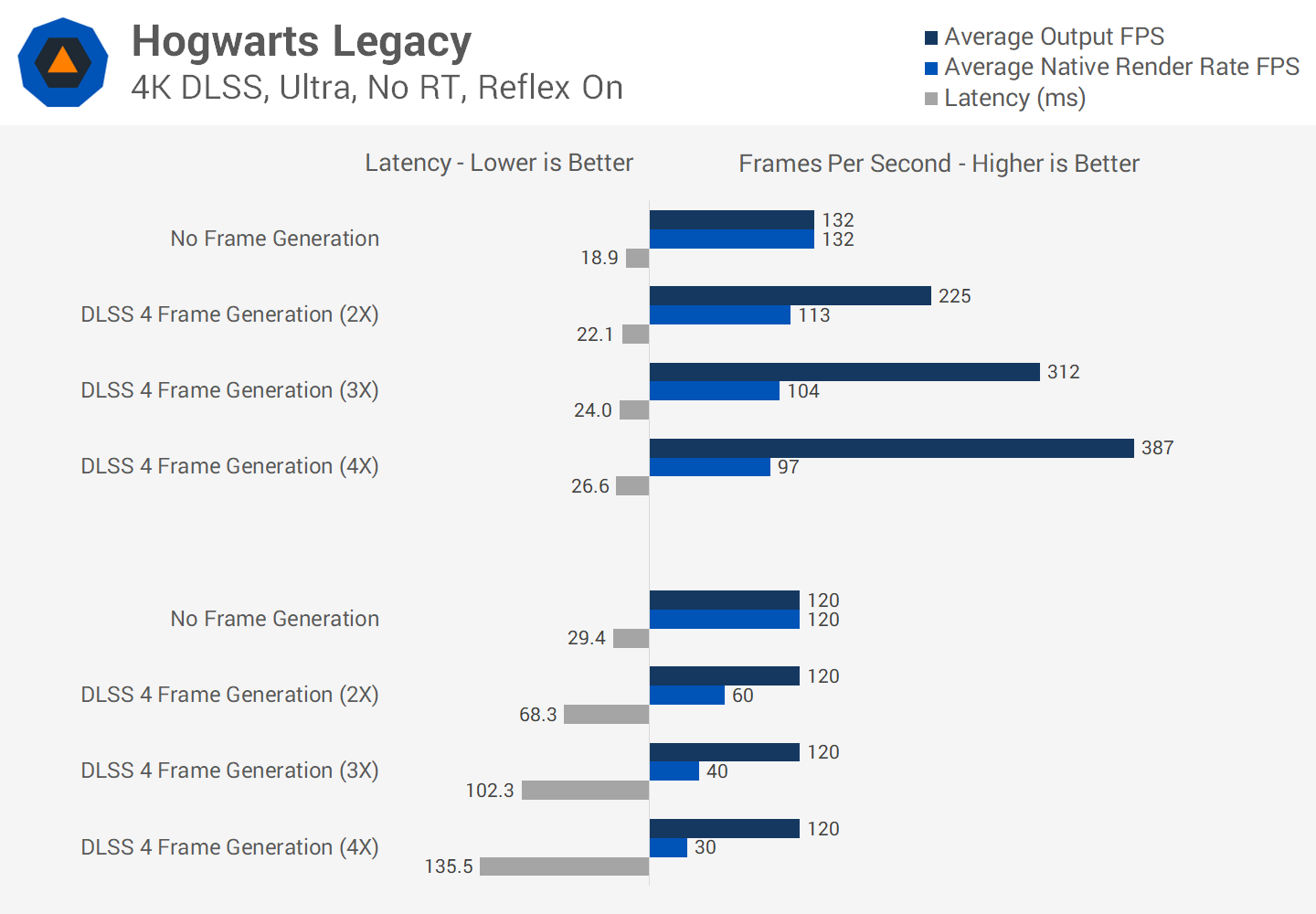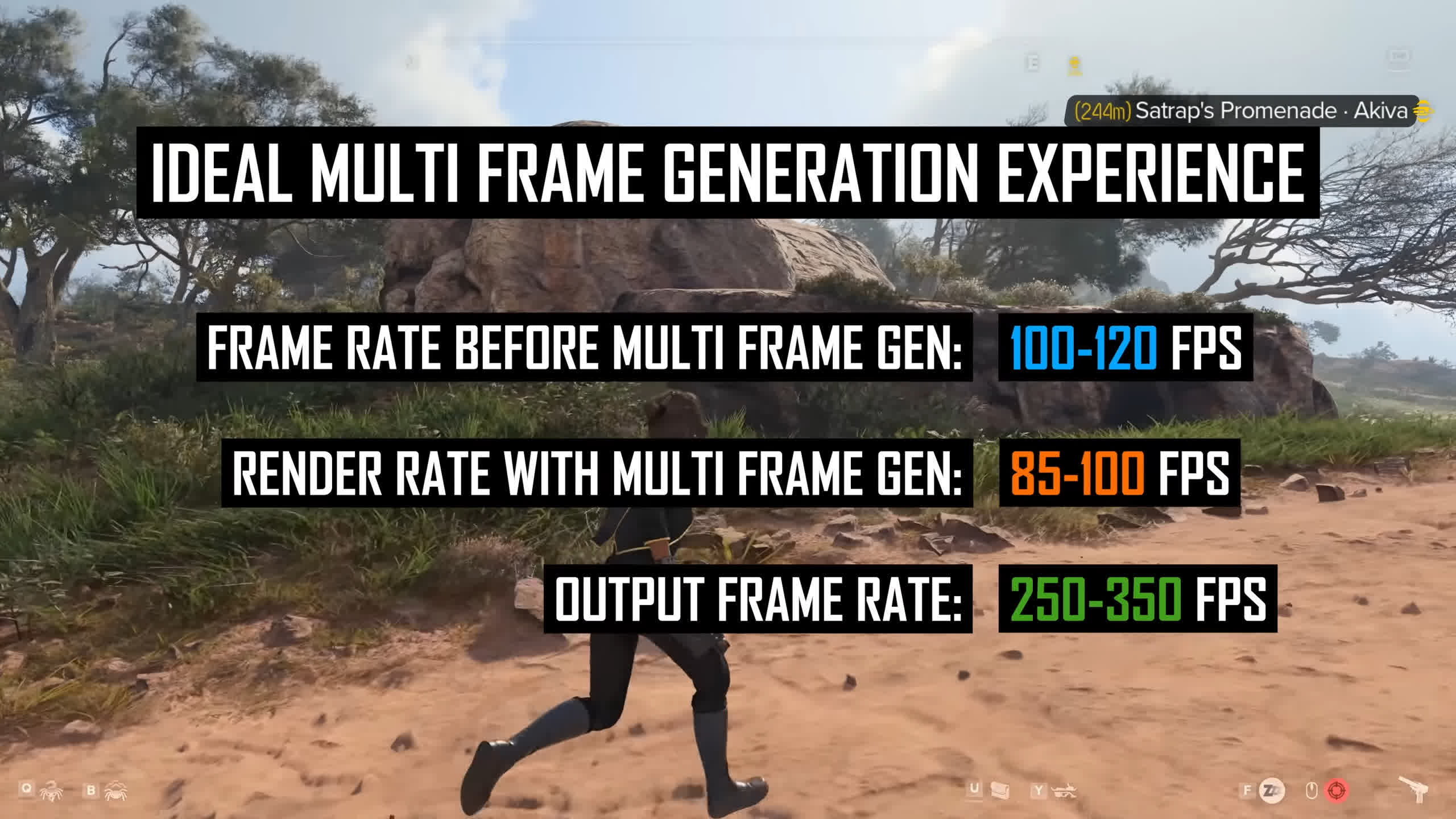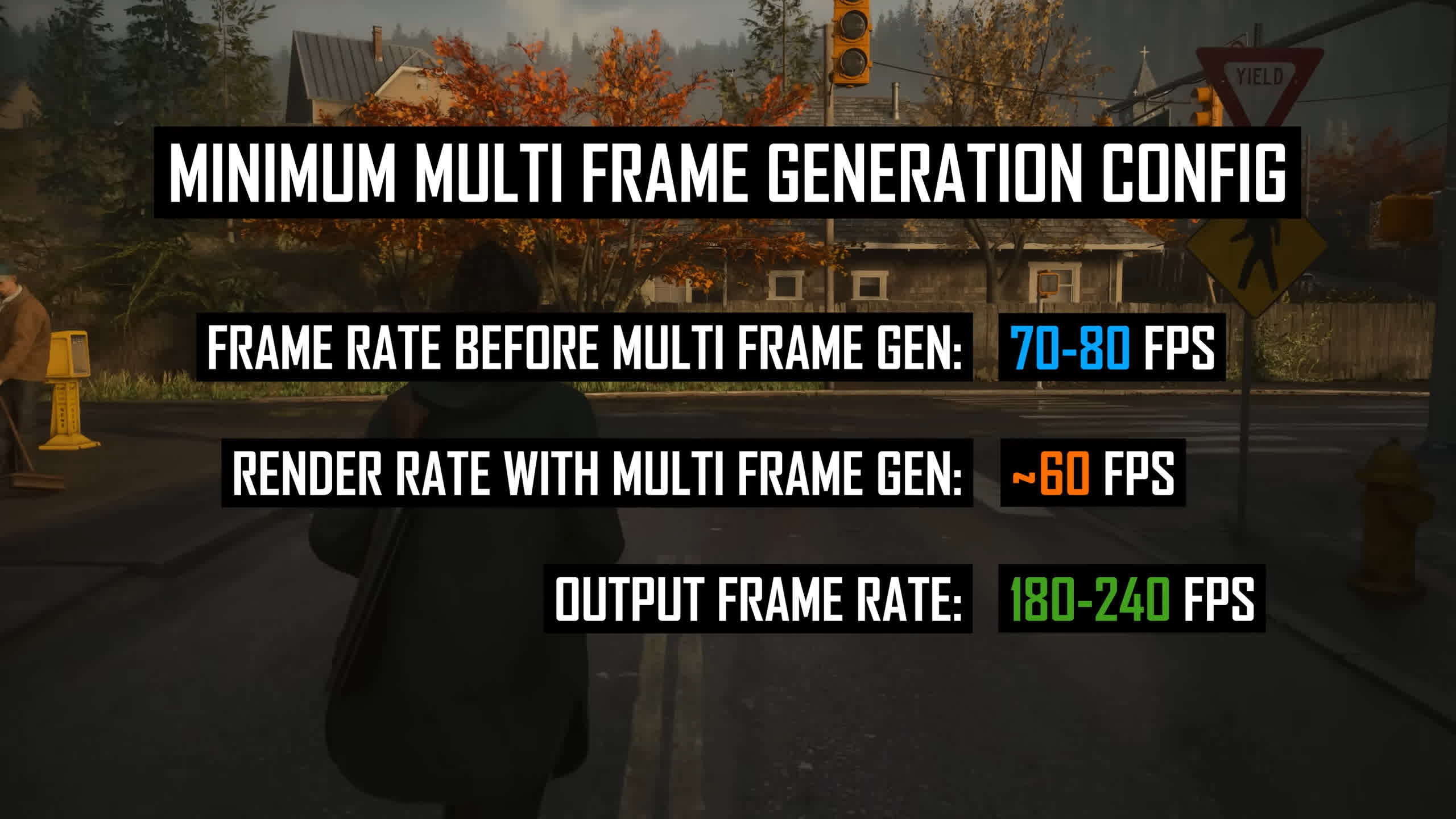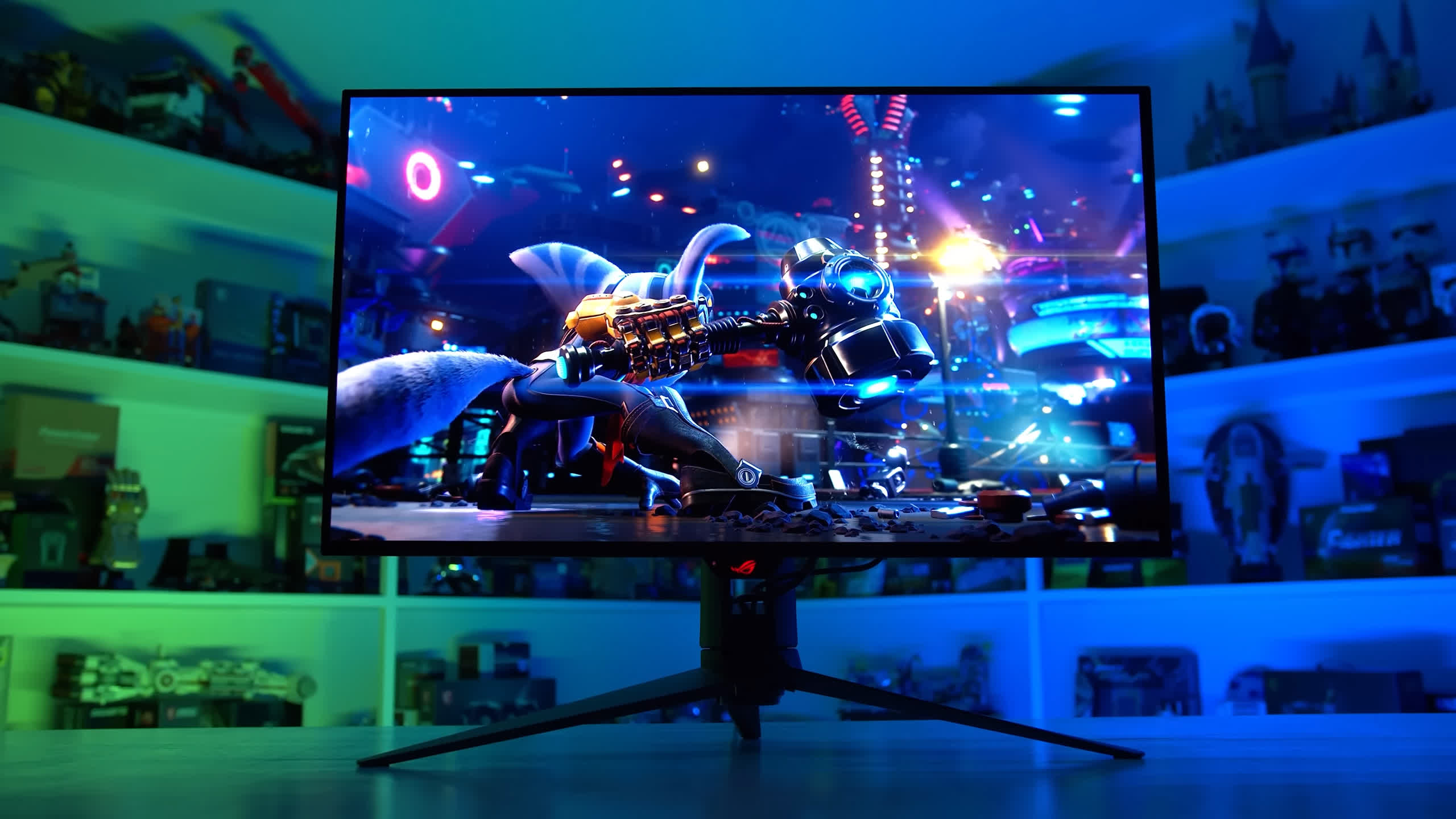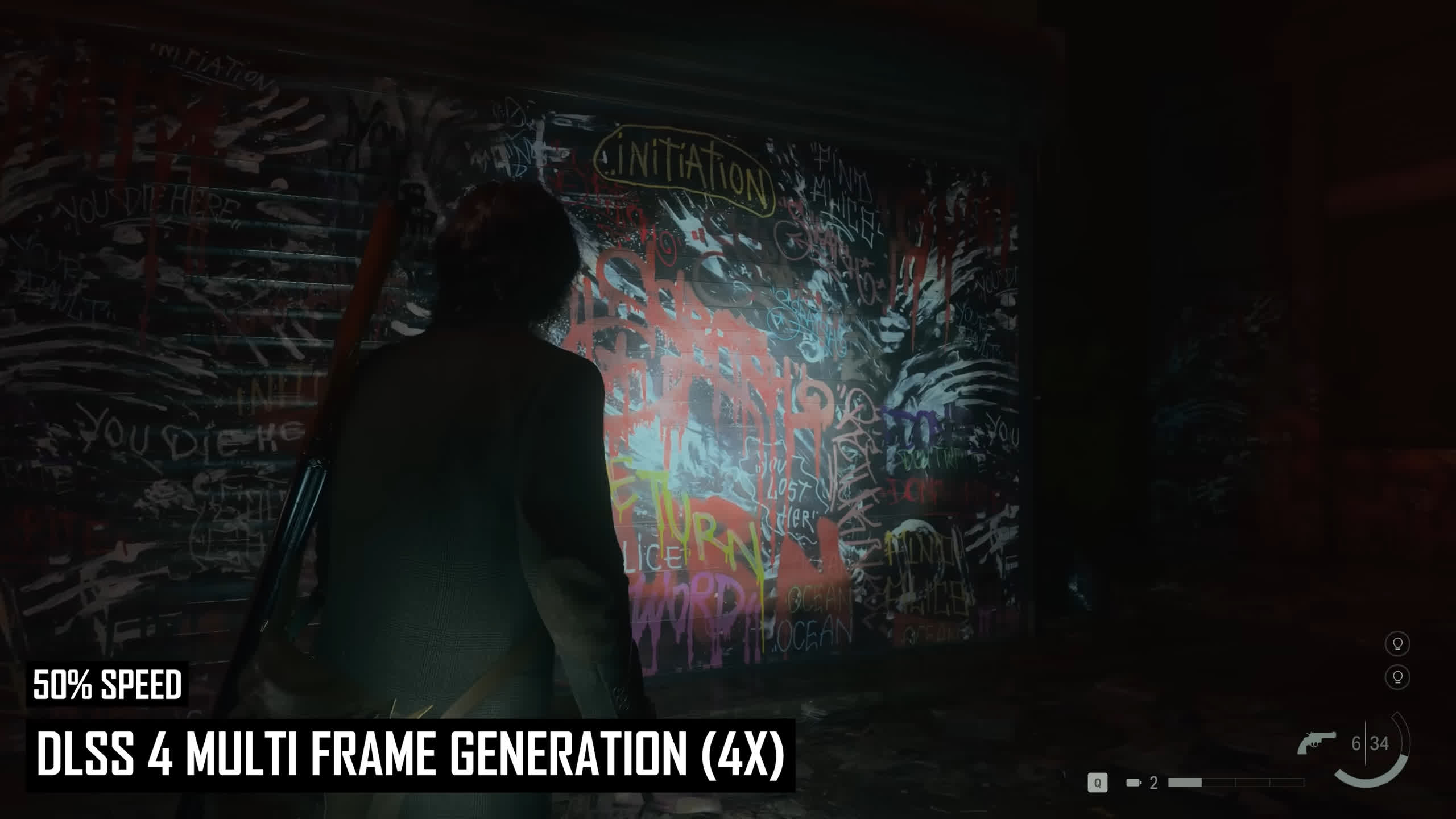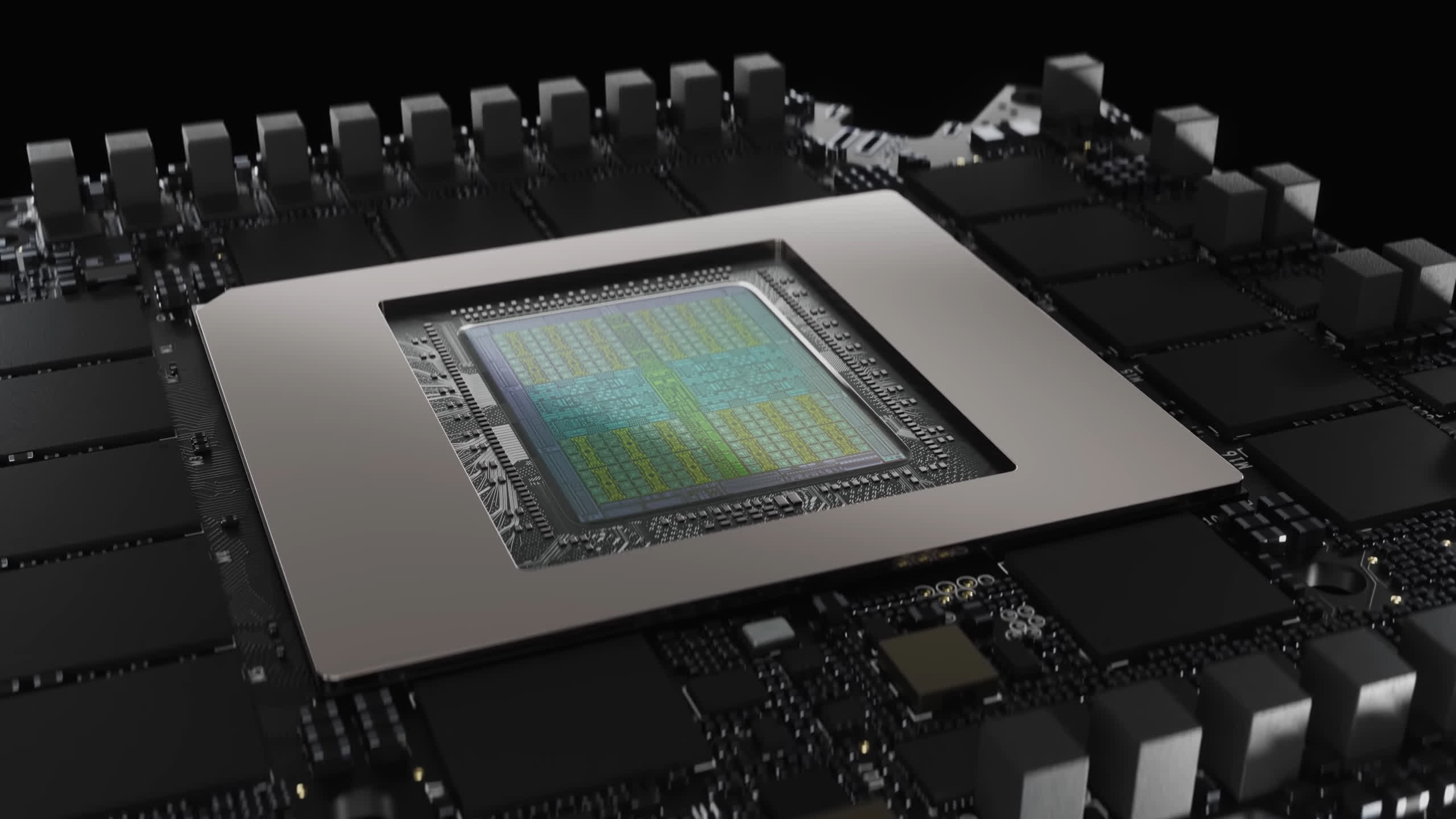DLSS 4 Multi Frame Generation is the latest technology Nvidia is using to market and sell gaming graphics cards. Exclusive to the new GeForce 50 series, including the RTX 5090 we recently reviewed, Multi Frame Generation is an evolution of frame generation technology that we’ve examined before.
Instead of generating one frame for every rendered frame, Multi Frame Generation allows up to three frames to be generated – so essentially, it’s just more frame gen…
DLSS 4 Includes More Than Just Multi Frame Gen
Now, Multi Frame Generation is just part of Nvidia’s DLSS 4 technology suite, but it’s the focus of this article because it’s the only component exclusive to the RTX 50 series.
DLSS 4 also includes updates to single frame generation, super resolution upscaling, and ray reconstruction, featuring upgraded models for better performance and image quality. However, those are not exclusive to the latest GPUs – these improvements to DLSS also work on existing GeForce RTX hardware.
In other words, you don’t need a GeForce RTX 50 series card to use most components of DLSS 4. In fact, the image improvements in this iteration of DLSS – going from a convolutional neural network to a vision transformer – likely provides the biggest improvement to DLSS since Nvidia introduced version 2.0 of the feature in 2020.
Having that said, Multi Frame Generation is the one feature Nvidia wants users to think is worth upgrading for and what they are using to claim dramatic performance boosts in this new GPU generation.
Multi Frame Generation is the one feature Nvidia wants users to think is worth upgrading for and what they are using to claim dramatic performance boosts in this new GPU generation.
We plan to cover other updates to DLSS 4 upscaling, ray reconstruction and single frame generation separately in future articles – but today we want to focus on the new multi frame gen feature to see how much value it’s bringing to the 50 series, and where it makes sense to use. We’re going to explore image quality, latency and FPS output in this review, so all of the usual good stuff.
The problem with testing Multi Frame Generation (MFG) is that it’s designed with high frame rate gaming in mind. At a base render rate of 60 FPS, Multi Frame Generation in its top mode will produce 240 FPS – well above what can be shown in a 60 FPS video sample on YouTube. And that’s without even considering whether a base render rate of 60 FPS is sufficient.
On top of this, capturing 240 FPS for visual analysis is not easy. There are no capture cards available that can capture 4K or 1440p at 240 FPS; this option is only available at 1080p, which isn’t a realistic use of the technology.
Locally capturing 240 FPS is also very challenging. We tried several solutions, but ultimately, at 1440p or 4K, it’s impossible to locally capture 240 FPS in a stable manner where every frame is accurately captured. Adding a second GPU to offload the encoding work didn’t help either – it’s just not feasible.
Unfortunately, this means for the visual analysis of Multi Frame Generation, we are effectively limited to 4K 120 FPS capture. This requires a base render rate of 30 FPS, a configuration we absolutely do not recommend and one that doesn’t showcase frame generation in the best light. However, this is how Nvidia recommends demonstrating the visual quality of Multi Frame Generation, so if it’s good enough for them, it’s good enough for us.
You’ll also see a lot of footage that’s slowed down because even 120 FPS can’t be displayed on YouTube. To make sure you can actually see every generated frame and what they look like, we’ll have to slow the footage down. Ideally, we’d create a 4K 240 FPS video to provide a real-world representation of the technology, but that’s not possible due to current hardware and platform limitations.
As we head into the visual analysis, we want you to keep a few things in mind:
- We do not recommend using frame generation at a base render rate of 30 FPS, even though some footage was captured this way.
- Capturing footage this way, and then slowing it down for display in a 60 FPS YouTube video, exaggerates the artifacts in the frame generation output.
- Please pay attention to the commentary where we describe how visible these issues are in real-world content displayed on a high-refresh-rate 4K 240Hz monitor. The footage in this article serves as a demonstration to highlight how frame generation impacts each frame.
How Does DLSS 4 Multi Frame Generation Work?
With DLSS 4 Multi Frame Generation, Nvidia’s algorithm generates up to three intermediate frames between two traditionally rendered frames. This process uses interpolation technology, meaning it relies on rendering two base frames and then creates additional AI-generated frames to fill in the gaps between them. These generated frames are inserted to improve motion fluidity and reduce latency, making the visuals smoother.
Importantly, this is not extrapolation, which predicts future frames; instead, it interpolates based on already-rendered before-and-after frames to maintain accuracy and consistency in the output.
DLSS 4 brings other improvements to frame generation: the optical flow pass has been replaced with an AI optical flow model, and with that, Nvidia claims performance improvements and a lower memory footprint. However, these improvements are accessible on both RTX 40 and RTX 50 series GPUs. So, all comparisons in this article, whether we’re looking at single or multi-frame generation, are using the new DLSS 4 version. Again, we want to focus on the benefits that 50 series owners are getting.
Speaking of that, Nvidia explains that multi-frame generation is not available on older GPUs because the Blackwell architecture includes a new capability called hardware flip metering, which is required for smooth multi-frame generation output. We have no way of verifying whether that’s true or what the experience would be like with multi-frame generation on a 40 series GPU without it – but hey, exclusive features are good for business.
Multi-frame generation (MFG) will be accessible through two methods. Some games will support it natively, allowing users to choose between three frame generation modes: 2X, which is the original single-frame generation experience, and the new 3X and 4X modes, which generate two and three additional frames, respectively.
These modes are labeled to describe the FPS output increase: the 4X mode generates three frames, which quadruples the FPS output. We don’t consider this a performance increase, so we’re not describing the gain that way.
The other method is through a DLSS Override, available in the Nvidia App. At launch, this is how the majority of those 75 games will support DLSS 4: the Nvidia App swaps the DLL for you. However, it’s a whitelist system, so you won’t be able to use the Override on games not on the list.
To use the Override, go to the graphics settings for a game in the Nvidia App and choose the amount of frame generation you want, such as the 3X or 4X modes. Then, when you’re in the game and enable frame generation, instead of the game using single-frame generation (the 2X mode), it will use the 3X or 4X mode, depending on your selection. It’s a bit clunkier than native game support because you can’t easily change the mode in the game, but it works.
Image Quality Analysis
Now let’s move into the image quality analysis. Everything you’re about to see in the video below was captured on the GeForce RTX 5090 at 4K, so we recommend watching at YouTube’s maximum resolution.
Since multi-frame generation is essentially just more frame generation, its visual strengths and weaknesses are similar to single-frame generation. In situations where frame generation improves smoothness, multi-frame generation makes it even smoother. However, in conditions where frame generation creates artifacts, multi-frame generation is likely to produce even more artifacts.
Frame generation technology shines in scenarios where motion is smooth and predictable or when scenes are relatively simple. In examples like Hogwarts Legacy, Alan Wake 2, and Cyberpunk 2077, Multi Frame Generation delivers impressive results, particularly during straightforward movements such as walking or driving.
The technology accurately interpolates background elements, creating native-like smoothness and enhanced motion clarity on high-refresh-rate monitors. Even fast-paced movements, like driving in Cyberpunk 2077, benefit from MFG when the environment is predictable and consistent.
However, the limitations of frame generation, especially with multi-frame modes, become evident in complex scenes, unpredictable motion, or when fine details like foliage are involved. Artifacts, such as blur, garbling, and visual instability, are more frequent in these scenarios.
For example, in Alan Wake 2, Multi Frame Generation struggled to render torch-lit areas properly, adding blur instead of clarity. Similarly, moving foliage in Star Wars Outlaws appeared blurry, as MFG failed to resolve fine details consistently. These issues are exacerbated by the increased reliance on generated frames in MFG’s higher modes (3X and 4X), which show artifacts more prominently.
While MFG works well at higher frame rates and in simpler environments, its artifacting becomes increasingly noticeable at lower base render rates, such as 30 to 120 FPS. At higher base render rates, particularly above 100 FPS, artifacts are harder to spot, making the technology more effective. Ultimately, MFG is an extension of single frame generation – its smoothness advantages are undeniable in optimal scenarios, but its propensity for artifacts makes it a mixed bag, especially in demanding scenes.
While much of the visual analysis has focused on the artifacts you can get with frame generation, we want to be clear that there are configurations and games where we were playing normally and didn’t really notice the issues. Typically, these were games with simpler environments played at a high frame rate. It wasn’t always the case that artifacts were visible; in some games, it was really just the occasional problem here and there.
Unfortunately, some of these issues are so noticeable that they can make the game look quite ugly and hurt the gaming experience, even if they only crop up occasionally. Whether those instances are worth it for an otherwise acceptable experience will ultimately come down to personal preference.
Benchmarks: FPS and Latency with Multi Frame Generation
When it comes to FPS output and latency, again, multi-frame generation is just more frame generation. This means the FPS output increases when multi-frame generation is used, but latency either stagnates or regresses relative to native rendering. This is why frame generation is NOT a performance-boosting technology, because performance is heavily linked to latency, and enabling frame generation actually makes latency worse.
Across the games tested, we’ve benchmarked at 4K using DLSS Quality with quality setting configurations that allow for an acceptable base frame rate, so the experience is something we’d actually recommend. There’s no point in benchmarking frame generation with a base frame rate of 30 FPS because we’d never recommend anyone play like that. All configurations have Reflex enabled because, again, why would you disable that feature if you’re interested in a fast, low-latency experience?
In Alan Wake 2, we recorded native non-frame-generated performance of 96 FPS on average, leading to 32ms of PC latency as reported through Nvidia’s latency measurement tool. When enabling 2X frame generation, the frame rate improved to 165 FPS, but latency worsened to 39ms. This is because you do get a 72% increase in output frame rate, but the render rate of the game – tied to latency – actually decreases from 96 to 83 FPS. This 14% reduction in render rate led to a 22% increase in latency.
Latency worsens further with multi-frame generation. The 3X mode delivered 232 FPS on average but latency of 42ms, and the 4X mode delivered 287 FPS but latency of 45ms. This meant the 4X mode pumped out 198% more frames, but the render rate dropped 25% due to the overhead of running frame generation, and thus latency was impacted.
Also seen in this chart is the frame rate of all configurations outputting 120 FPS. This again disproves that a frame rate with frame generation enabled is equivalent to a frame rate with frame generation disabled. The latency of 120 FPS using MFG 4X is over four times higher, meaning the game feels four times more sluggish – more in line with a 30 FPS experience. When Nvidia claims that an RTX 5070 is equivalent to an RTX 4090 because the multi-frame generation FPS output is the same, they’re failing to mention that the latency is much worse in the configuration using more frame generation, which is deceptive and misleading.
The latency impact from multi-frame generation is generally pretty similar between games.
In Star Wars Outlaws, we had the game running at 110 FPS natively. With FG 2X, this improved to 180 FPS, then 254 FPS with MFG 3X, and 317 FPS with MFG 4X. However, the latency increased from 23ms to 30ms to 31ms to 32ms with each increase in frame generation.
When looking at render rate, running MFG 4X caused a 30 FPS loss, which is why the game’s latency went up. Ultimately, you go from a 110 FPS experience in terms of “feel” to a 79 FPS experience – still pretty good for a single-player game, which is why we recommend a starting frame rate above 100 FPS, but a reduction nonetheless.
The overhead associated with frame generation in Cyberpunk 2077 was less severe. At a base frame rate of 78 FPS, enabling frame generation saw an output of 139, 197, and 250 FPS from each of the modes respectively – up to a 221% increase. However, latency also increased from 34ms to 44ms in order to run the frame generation algorithm, dropping the render rate as low as 62 FPS.
Lastly, we tested Hogwarts Legacy, where, again, we’re seeing the same thing. In this game, the MFG 4X mode delivered a frame rate output three times higher than native rendering, but latency also worsened from 19ms to 27ms. When looking at the fixed output experience, latency went from 30ms to a shocking 136ms, which makes the game feel absolutely awful.
Now, Nvidia claims that there isn’t much of a latency penalty from generating additional frames, so the feel of games shouldn’t change much between single-frame and multi-frame generation.
This is true in the sense that in some games, the majority of the latency increase occurs when going from native rendering to single-frame generation. In Star Wars Outlaws, for example, there was a 6ms penalty to enabling frame generation, but it cost just an additional 2.5ms to enable 4X multi-frame generation. In Cyberpunk, it was a 6ms penalty to enable frame generation, then another 4ms to enable 4X multi-frame generation. In other games like Hogwarts Legacy, the scaling was more linear between each step.
But the reality is that even on an RTX 5090, there is overhead associated with generating more frames – creating those extra frames is not “free.” The render rate decreases as you enable more frame generation, and latency is higher than with single-frame generation.
This is something you’ll have to factor into the base frame rate you’re hitting before enabling frame generation. Essentially, this makes frame generation a much more expensive but much more effective version of motion blur, which has been used in the past to achieve a “smoothed” presentation like frame generation is providing now.
When Using Multi Frame Generation Actually Makes Sense
The simplest way to describe DLSS 4 Multi-Frame Generation – and the way we’ve been describing it throughout this article – is that it’s more frame generation. Overall, it creates a higher output frame rate and gives you more smoothness than single-frame generation, but it’s also prone to producing more artifacts, and there’s a slightly higher latency cost. All of the strengths of single-frame generation are amplified, and all of the weaknesses are also amplified.
All of the strengths of single-frame generation are amplified with Multi Frame Generation, and all of the weaknesses are also amplified.
Does this make Multi-Frame Generation better than Single-Frame Generation? … we guess it does, sometimes…? It really depends on whether you’re on the good side of frame generation or the bad side.
In the best conditions, Multi-Frame Generation is smoother, clearer, and makes better use of your high refresh rate monitor. In the worst conditions, the flaws make it even less usable and more problematic than single-frame gen. This can vary on a game-by-game or even scene-by-scene basis, but at best, we’d describe it as an inconsistent improvement.
The issue with see with the usability of Multi-Frame Generation is that it doesn’t lower the bar for when frame generation is useful and neither does it change its requirements. The technology still works best at a high base render frame rate (100+ FPS), so that the difference between frames are small, this minimizes artifacts, and the latency of the game is still relatively good.
It’s not a situation where you’d now consider using frame generation at a base 30 FPS where previously you’d only have considered it at 60 FPS – the quality of the experience is still heavily linked to the actual render rate of the game, even if the output frame rate is now higher.
Bottom line is that our recommendation on the usability of frame generation is unchanged. For the best experience, we recommend a starting frame rate of 100 to 120 FPS for a smooth, clear, artifact-free, low-latency gaming experience. Enabling multi-frame generation will typically lower your render rate to around 85 – 100 FPS but spit out 250 – 350 FPS. That’s a really good experience because artifacts are not very noticeable at that kind of frame rate, and the latency experience we typically associate with 85 – 100 FPS single-player gaming is good.
If you’re less sensitive to latency and don’t care too much about the responsiveness of a high refresh rate, then the minimum we’d recommend for multi-frame generation is a starting frame rate of 70 – 80 FPS. Enabling MFG will lower your render rate to around 60 FPS and pump out 180 – 240 FPS, maxing out your high refresh rate monitor while still delivering the responsiveness of 60 FPS gaming, which for many PC gamers is the minimum acceptable level.
Try to use frame-gen at anything below this, and the feel of the output becomes quite bad – very rubbery, slow, and unpleasant. Plus, artifacts become significantly more noticeable. If your base frame rate is in the 30 – 40 FPS range, it’s a bad experience, especially if you compare it directly to a non-frame-generated high FPS output.
DLSS 3 (SFG) vs DLSS 4 (MFG): Caveats and Considerations
Frame generation has existed since the release of DLSS 3, so we’ve had our fair share of experiences with it, and we’ve found that these FPS requirements will also heavily depend on the style of game and the input method.
Frame generation tends to require a higher render rate when it’s a first-person game, when it’s a faster-paced game, or when using a mouse and keyboard. That’s usually when we’d want a minimum of 120 FPS before enabling frame generation. If the game is third-person, a bit slower-paced, or when the best way to play is with a controller, the latency becomes less noticeable, and we’re fine with 80 FPS before enabling frame generation. None of that has changed based on our experience with multi-frame generation so far.
With these requirements in mind, we could also observe that multi-frame generation is typically not nearly as much of an improvement as single-frame generation to the gaming experience. Take our minimum recommendations…
With single-frame generation enabled, you’d go from about 75 FPS to about 120 FPS – a noticeable improvement to smoothness, especially on a high-performance OLED monitor. But with multi-frame generation, the added benefit is going from 120 FPS to either 180 or 240 FPS. That’s a good gain, but not nearly as significant as the gain provided through previously available single-frame gen that doesn’t require an RTX 50 series GPU. It can feel like diminishing returns at those higher frame rates, though there are benefits to smoothness and motion clarity if the generated frames are of suitable quality, which they often are at those frame rates.
This also makes multi-frame generation essentially useless if you don’t have a very high refresh rate monitor. We’re talking 240Hz minimum, but ideally 360Hz or even 480Hz if you want to take full advantage of the 4X mode. Generating more frames than your display can actually show is pointless (and could even lead to high-quality rendered frames not being fully shown). With multi-frame generation, the output is usually quite high. Therefore, a very high refresh rate display is a requirement, which the majority of gamers don’t own.
Take a typical 1440p 165Hz monitor, for example – the bang-for-buck category these days. With single-frame generation, you could take that 75Hz experience up to 120Hz. But using 3X multi-frame generation would exceed your monitor’s refresh rate with a 180 FPS output. If you capped the frame rate to 165 FPS to prevent tearing, you’d end up lowering the render rate to just 55 FPS, giving you a sub-60 FPS latency experience. And that’s the 3X mode, so you can forget about the 4X mode providing any sort of benefit.
Frame generation is pointless for multiplayer games, for it to make sense, you have to be a single-player gamer who is already rendering the game at a reasonable frame rate, owns a 240Hz or faster monitor, notices the additional smoothness relative to single-frame generation, and is okay with the trade-off between smoothness and latency/artifacts. That’s a pretty niche use case.
This further adds to the list of criteria for a good frame generation experience and further restricts where it makes sense to use the technology. Frame generation is pointless for multiplayer games, for it to make sense, you have to be a single-player gamer who is already rendering the game at a reasonable frame rate, owns a 240Hz or faster monitor, notices the additional smoothness relative to single-frame generation, and is okay with the trade-off between smoothness and latency/artifacts. That’s a pretty niche use case.
As Nvidia continues to develop these exclusive DLSS technologies, they’ve gotten less broadly usable over time. DLSS 2 upscaling was great because it was widely useful to nearly all types of gamers. DLSS 3 frame generation started to restrict the pool to single-player gamers already achieving a certain level of performance. And now, with DLSS 4 frame gen, you have to consider your monitor’s refresh rate and your sensitivity to smoothness gains.
We had a good time using MFG on a 4K 240Hz OLED monitor with a GeForce RTX 5090. But that’s a $1,000 monitor and a $2,000 graphics card. How useful is it going to be for someone with a mid-range setup? We believe it’s not going to be useful at all. And this is especially important to understand because that’s not to the pitch Nvidia is making to gamers, marketing DLSS 4 as a magical technology capable of doubling or tripling your effective FPS experience.
… and this is especially important to understand because that’s not to the pitch Nvidia is making to gamers, marketing DLSS 4 as a magical technology capable of doubling or tripling your effective FPS experience.
Ultimately, we don’t think DLSS 4 Multi-Frame Generation adds much value to the GeForce RTX 50 series, and for most people, it’s not worth upgrading for. It’s going to be good for some people, maybe even great, but that group is too small and niche for it to bring value to the average gamer with an average setup.
Nvidia needs to stop blatantly misleading buyers by comparing two different frame generation configurations and claiming they offer a similar experience. A 120 FPS output from single-frame generation and a 120 FPS output from multi-frame generation are worlds apart in image quality, and especially latency. Claiming that because the output frame rate is the same, the two configurations offer the same “performance” is a joke when it omits relevant key information.
Claiming those kind of things also taints frame generation, which can be a beneficial technology in terms of improving smoothness and image clarity. Making up nonsense about what frame generation can do to fool some people and force more GPU sales, instead of talking about the actual genuine benefits of frame generation, is very frustrating.
Source link
